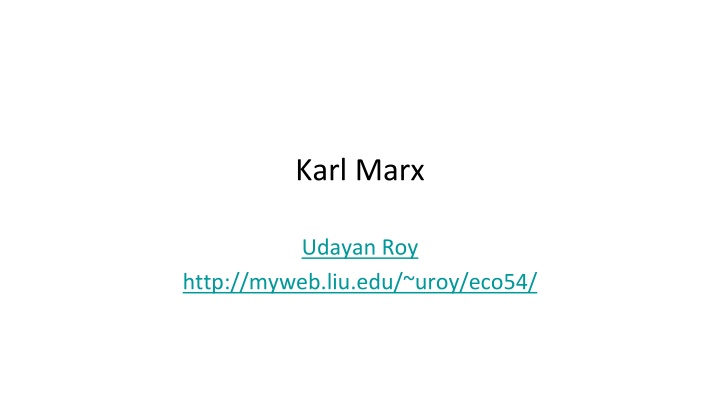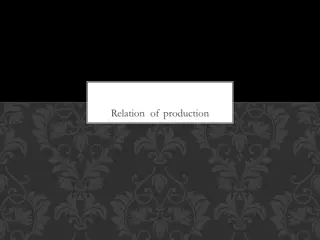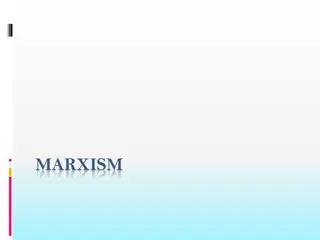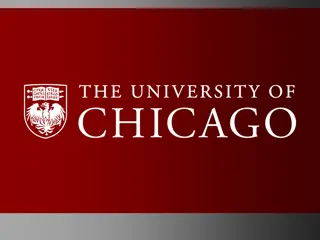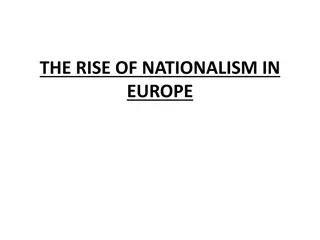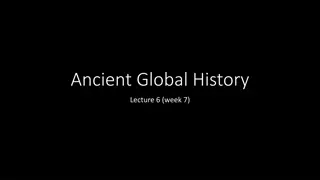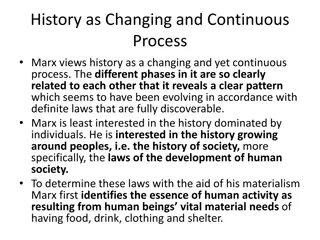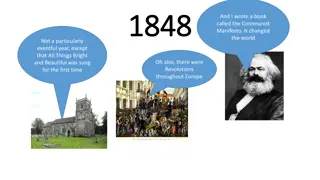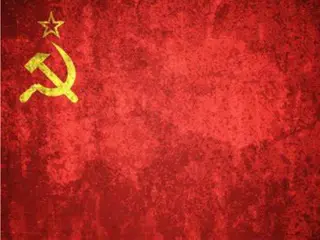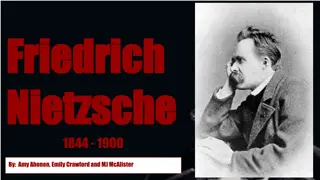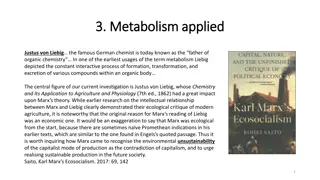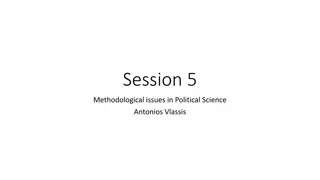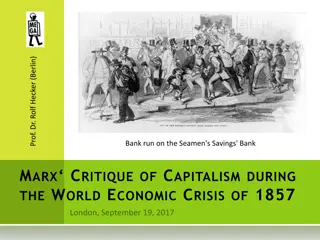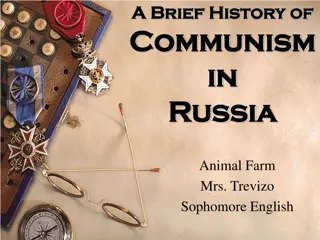Karl Marx: The Revolutionary Thinker and Philosopher
Explore the life and theories of Karl Marx, a prominent figure in political philosophy and economics. Discover his works such as "Capital" and "The Communist Manifesto," as well as his theory of history and dialectical materialism. Learn about the impact of technology and power on the mode of production according to Marx's ideas.
Download Presentation

Please find below an Image/Link to download the presentation.
The content on the website is provided AS IS for your information and personal use only. It may not be sold, licensed, or shared on other websites without obtaining consent from the author.If you encounter any issues during the download, it is possible that the publisher has removed the file from their server.
You are allowed to download the files provided on this website for personal or commercial use, subject to the condition that they are used lawfully. All files are the property of their respective owners.
The content on the website is provided AS IS for your information and personal use only. It may not be sold, licensed, or shared on other websites without obtaining consent from the author.
E N D
Presentation Transcript
Karl Marx Udayan Roy http://myweb.liu.edu/~uroy/eco54/
Karl Marx (1818-1883) Capital Vol. 1 (1867) Vol. 2 (1885) Vol. 3 (1894) The Communist Manifesto (1848) By Karl Marx and Friedrich Engels KARL MARX
Sources: Karl Marx The Ordinary Business of Life by Roger E. Backhouse, pages 156-165 The Worldly Philosophers by Robert L. Heilbroner, Chapter VI (The Inexorable System of Karl Marx) New Ideas from Dead Economists by Todd Buchholz, Chapter VI (The Angry Oracle Called Karl Marx) KARL MARX
Karl Marx (1818-1883) Theory of History Theory of Capitalism Formal Economics: The First Two-Sector Growth Model KARL MARX
MARXS THEORY OF HISTORY KARL MARX
Theory of History Marx s theory of history is called Dialectical Materialism. It is derived from Hegel s idea that history follows a pattern of progress through (ideological) conflict thesis, antithesis, synthesis called the dialectic and Feuerbach s idea, called materialism, that the ideas that people come up with are their ways of making sense of the material conditions they are in. KARL MARX
Dialectical Materialism The three main ingredients of Marx s theory are: Productive Forces: natural resources and technology. Productive forces can change when there are discoveries, inventions, and conquests of other countries and colonization of other lands. Mode of Production: economic system. The most important thing to look for in an economic system is the relation between and the distribution of power among the various classes. Ideological Superstructure: government, law, politics, religion, art, literature, philosophy, science, etc. KARL MARX
Technology And Power When productive forces change, the mode of production needs to change This is because for every set of productive forces there is a unique set of class relations that is appropriate. That is, for every set of productive forces there is a unique distribution of power among the various classes. KARL MARX
Ideological Superstructure Changes in the mode of production will be resisted by the ideological superstructure which is determined by the current the mode of production. When productive forces change, the mode of production needs to change. But the current mode of production uses its control over the ideological superstructure to resist any change in the mode of production. That is, the dominant class resists the loss of dominance. KARL MARX
Revolution When the productive forces keep changing but the mode of production stubbornly refuses to change, forces of change begin to build up. When these forces gain enough strength, they unleash a revolution that forces a change in the ideological superstructure and thereby bring about the necessary change in the mode of production. That is, because of the ability of the dominant class to resist, at least temporarily, any challenge to its dominance, change will only happen in spasms called revolutions. KARL MARX
Revolutionary Change When the mode of production changes as a result of changes in productive forces and the revolution it unleashes society could go from having one type of class inequality to another type of class inequality, or from a society with class inequality to a classless society. KARL MARX
Revolutionary Change When one kind of class inequality is replaced by another kind of class inequality, the process of change will continue. When productive forces change again, there will eventually be another revolution leading to a new mode of production. KARL MARX
The Culmination If, on the other hand, an unequal society is replaced by a classless society that is when, the new mode of production is a classless society the pattern of continuous change will come to an end. Future changes in productive forces will not cause revolutions or changes in the mode of production. KARL MARX
An Illustration Marx showed how social changes from primitive society to slavery to feudalism to capitalism fit his theory. KARL MARX
Capitalism Marx argued that a new form of class inequality, called capitalism, characterized the society at the time of his writing. His theory implied that there would have to be a revolution that would destroy capitalism. The eventual replacement would be communism. Communism would create a classless society and, therefore, it would be the final and permanent state of society. KARL MARX
Scientific Socialism Marx was not saying that capitalism would collapse because it was immoral or because it was inefficient. He was saying that capitalism would collapse because of the unalterable rules of social change that invariably destroy economic systems marked by class inequality. This is why another name for dialectical materialism is scientific socialism. KARL MARX
MARXS THEORY OF CAPITALISM KARL MARX
Marxs Theory of Capitalism Marx argued that the only source of a firm s profit is the labor it employs. Marx based his view on an application of the Labor Theory of Value. Simply put: Machines without workers are useless. Workers without machines, on the other hand, are not useless because the workers can make the machines that they need to do their work. Therefore, in a sense, all production is done by labor. Income of capital is purely exploitation KARL MARX
The Exploitation of Labor Workers need tools (the means of production ) to produce things Capitalists have the tools, the workers don t Capitalists end up as the workers bosses Because there are many workers but not that many capitalists, and there always exists a reserve army of the unemployed to scare workers who may wish to ask for more than subsistence KARL MARX
The Exploitation of Labor Capitalists use the workers labor time to produce commodities Labor time is the socially accepted length of the typical working day Example: It may be traditional for workers to work ten hours a day. In this case, the labor time taken by the capitalist is ten hours per day KARL MARX
The Exploitation of Labor But capitalists pay the workers for their labor power Labor power is simply the ability to work The payment for labor power is the subsistence wage, the bare minimum for labor to survive Example: If it took six hours of labor to produce the goods a worker and his family needed to survive for a day, the value of his labor power was six hours per day KARL MARX
The Exploitation of Labor The excess of labor time, which the capitalist takes from the worker, over labor power, which the capitalist pays to the worker, is the capitalist s profit or surplus value Example: The capitalist may take 10 hours of a worker s day (labor time) and pay him 6 hours per day (labor power). Surplus value is 4 hours per worker per day This surplus value represents exploitation KARL MARX
The Exploitation of Labor Note that the surplus value taken by the capitalist Increases when the length of the working day (value of labor time) increases, and Decreases when the subsistence wage (value of labor power) increases Historically, a great deal of the struggle between workers and bosses has been over the length of the work day KARL MARX
Irrational Capital Accumulation In spite of the fact that surplus value derives from the exploitation of labor, capitalists have an irrational belief that profits come from the capital goods (that is, machines and tools) they employ in their firms. As a result, they obsessively strive to accumulate capital goods. KARL MARX
Falling Rate of Profit This increases their expenses but, alas, not their profits, because only labor can generate profits So, their rate of profit declines. Recall that Ricardo had earlier derived the falling rate of profit KARL MARX
Crises Business crises are a perpetual feature of capitalism. Why? Recall that capitalists obsessively accumulate capital At times, the accumulation of capital becomes too rapid At such times, production increases faster than demand Market gluts appear and goods go unsold Many capitalists are forced to shut down KARL MARX
Crises Now, recall the falling rate of profit When the overall rate of profit is low, smaller firms are especially vulnerable to business crises. They get taken over by larger firms. This concentrates power in the hands of fewer and fewer firms. Moreover, the middle class capitalists who sell their small firms to the big firms then become new members of the working class. KARL MARX
Exploitation When big firms become bigger and even more powerful, they try to boost their profits by increasing the pressure on workers to, for example, work longer hours, work for lower wages, etc. KARL MARX
The End At some point, the growing but increasingly oppressed working class turns on their capitalist oppressors. This unleashes a revolution and brings about the end of capitalism. KARL MARX
Then What? Capitalism would be replaced by socialism and then communism, the final state of society Under communism, there would be no classes, and therefore no class conflict, and therefore no need for a new mode of production But exactly would life under communism feel like? KARL MARX
Then What? Marx did not fully describe his vision of life under communism However, there is an evocative passage in his The German Ideology (1846) The following passage can also be seen as Marx s criticism of what the division of labor under capitalism does to workers KARL MARX
Then What? For as soon as the distribution of labour comes into being, each man has a particular, exclusive sphere of activity, which is forced upon him and from which he cannot escape. He is a hunter, a fisherman, a herdsman, or a critical critic, and must remain so if he does not want to lose his means of livelihood; while in communist society, where nobody has one exclusive sphere of activity but each can become accomplished in any branch he wishes, society regulates the general production and thus makes it possible for me to do one thing today and another tomorrow, to hunt in the morning, fish in the afternoon, rear cattle in the evening, criticise after dinner, just as I have a mind, without ever becoming hunter, fisherman, herdsman or critic. KARL MARX
Assessment Marx s predictions have not come true. Capitalism is alive and well. The rate of profit shows no signs of falling over time; it is pretty stable. Workers have not become worse off over time; wage incomes have risen at about the same rate as capital income. Besides, the nature of capitalism has changed. Even workers own stocks and bonds nowadays and have an interest in the good health of capitalism. Democracy and its social welfare laws have tempered capitalism s worst excesses. Marx s theories may have ended up saving capitalism by convincing capitalist societies of the need for a certain level of fairness. KARL MARX
MARXS TWO-SECTOR GROWTH MODEL KARL MARX
Formal Economics: The First Two-Sector Growth Model There are two sectors in Marx s theory: one produces capital goods and the other produces consumer goods. Workers earn wages and capitalists earn profits. Workers spend all their earnings on consumer goods they don t save. Capitalists spend part of their income on consumer goods and save the rest. KARL MARX
Saving Growth Capitalists savings are used to pay for more capital goods (i.e., machines or fixed capital) and to hire more labor (i.e., workers or circulating capital). The economy grows rapidly when the employment of machines and workers increases rapidly. But this would happen only if the capitalists save a lot. KARL MARX
Profits + Thrift Saving Capitalists would save a lot if they earn high profits and if they have a high propensity to save out of those profits. KARL MARX
Exploitation + Workers per Machine Profits Capitalists will earn high profits if the profit per worker (which Marx referred to variously as the rate of surplus value and the degree of exploitation) is high and if capitalists use a high proportion of workers relative to machines (Marx referred to the inverse of this ratio as the organic composition of capital). KARL MARX
Thrift + Exploitation + Workers per Machine Growth Therefore, an economy s growth rate is directly related to the propensity to save and the rate of surplus value and is inversely related to the organic composition of capital. See page 160 of Ordinary Business of Life by Roger Backhouse KARL MARX
Assessment This was the first two-sector model of balanced growth. It was similar to and in some ways more advanced than the famous Harrod-Domar growth model, which had just one sector. However, Marx s model was sketchy and fragmentary (and was salvaged from his notes and reconstructed by Friedrich Engels and other economists) whereas the Harrod-Domar model was fully worked out. It is odd that the main bit of formal economics to come out of Marx is a theory of balanced growth even though Marx s intention was to demonstrate the unsustainability of capitalism. KARL MARX
Unique Although the prosperity of nations was a central concern of all classical economists, Marx was the first to devote himself exclusively to finding ways to rescue the poor people of the world. He was also unique in incorporating ideas from the full spectrum of social science into his work. KARL MARX
Any Questions? KARL MARX
